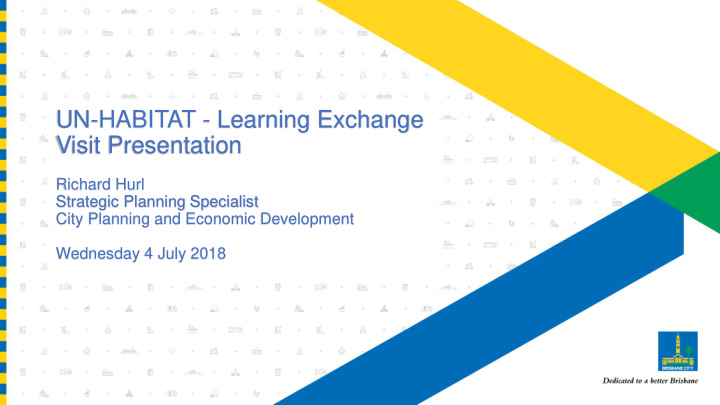



UN-HABITAT - Learning Exchange Visit Presentation Richard Hurl Strategic Planning Specialist City Planning and Economic Development Wednesday 4 July 2018
Brisbane – a growing city • Estimated Resident Population as at 2017: 1,206,607 persons - Growth of 19.4 per cent from 2007 to 2017 (an average of 1.94 per cent per year) • Projected population by 2036 (medium series): 1,433,675 persons • Brisbane Local Government Area (LGA) – Area of 1,382 km 2 • Brisbane LGA is the largest LGA, in terms of population, in Australia. It was formed by the merger of twenty smaller LGAs in 1925
A growing region • Estimated Resident Population as at 2017: 2,408,220 persons - Growth of 12 per cent from 2011 to 2017 (An average of 2 per cent per year) • Projected resident population by 2036 (medium series) 3,326,533 persons
The planning and building system in Brisbane • Planning and building • National Construction Code (Australian Buildings Code Nation Board/ Australian Government) legislation are separate • National and state building provisions include building • Planning Act 2016 (Queensland Government) resilience measures • State Planning Policy 2017 (Queensland Government) • South East Queensland regional Plan 2017 (Shaping SEQ) • The state wide planning (Queensland Government) Region / State policy mandates the • The State Infrastructure Plan 2016 (Queensland Government) approach to managing • Queensland Building Act 1975/ Queensland Development growth in areas subject to Code (Queensland Government) natural hazards • State and regional planning City • Brisbane City Plan 2014 (Brisbane City Council) requirements are delivered through local planning Neighbourhood • Neighbourhood Plans (Brisbane City Council) schemes Site • Development Applications (Brisbane City Council)
Brisbane City Plan 2014 – Provisions Living in Brisbane Brisbane City Plan 2014 – key components: • Ensure the right uses in the right CityShape place where natural hazards occur • Strategic Framework Brisbane Economic DP • Mitigate hazards through design • Zoning requirements such as setting • Planning Act 2016 Neigbourhood Plans minimum floor levels • avoid intensification of uses in areas • SEQ Regional Plan Overlays where hazards cannot be mitigated • Use and Development SEQ Infrastructure Plans • Emergency management/ Codes State Planning Policy 2017 community information and hazard • Infrastructure Plan mitigation infrastructure are also Flood outcomes used to manage natural hazards • Planning Scheme Policies Other BCC plans, operations. strategies, policies, regulation and local laws
Brisbane – a subtropical city • 27.4698 ° S, 153.0251 ° E • Humid subtropical climate – hot, wet summers, with average maximums of above 26 ° C from September through to April. • Short, warm winters, with average maximums of about 22 ° C • 1000+mm of rainfall • Tropical cyclone risk is rare • Located on the Brisbane River flood plain • Moreton Bay protected by Moreton and Stradbroke barrier islands.
Vernacular architecture responds to climate & flooding “ The elevated house, with its expanse of verandah, plethora of timber for walls, floors, stairs, decorative elements and stumps, prominent tin roof and economy of material all go into creating this characteristic Queensland house form. ” – Judy Rechner
Our Changing Climate
Overview Northern Beaches Impacted Properties: Nudgee Beach Storm Tide: 24,000 Sea Level Rise: 14,600 Australian Source: Geoscience Australia Trade Coast High Hazard Area (1m+) Southern Albion Medium Hazard Area (less than Beaches 1m) Erosion and permanent tidal inundation due to sea level rise by 2100. * 1100mm high end scenario
1: Australia Trade Coast Fishermans Luggage Island Point STP • SEQRP Major economic centre – industry • $10 billion exports (2031) BP • Est. workforce: (NIEIR) Caltex ~ 56 000 current ~ 79 000 at 2021 ~ 90 000 at 2031 Residential Population: 2,684 Gibson Island • Major infrastructure investments • Utilities: Sewage treatment – 85% of Brisbane's supply
• Regionally significant industry intent • High-value land holdings • Small, medium, large & government business stakeholders & Pinkenba Village • No existing protection works to ATC North.
Northern Shores Low growth residential area 3,056 affected properties 68% own or purchasing homes (Bne~59%)
• Some existing sea defences (sea wall) • Tin and timber architecture • Current king tide flooding • About 20% of population > 65 • High to low property values • Varied income levels • Disaggregated land holding pattern Northern Shores – Brighton, Sandgate, Shorncliffe
The way forward State Planning Policy 2017 identifies local government as the lead agency to utilise integrated evidence based processes to join with the community and plan for local circumstances. • Slow onset risk • Defend/ adapt/ retreat • Context specific responses • The role of business and the Community • Cost benefit analysis Resumption of land for Airport: 1971 - 1980 • Integrated, multi disciplinary responses • Cost sharing arrangements for infrastructure costs • Inter-governmental collaboration • Dedicated delivery authority • Additional legislative powers, including compulsory acquisition • Adaptation planning obligation • Balancing disparate investor interests
Coastal Hazard Adaptation Strategies Resilience to hazards has long been part of our story and future responses are being shaped by new adaptation strategies. QCoast 2100 is a three year, 12 million dollar, partnership between the state Government and the Local Government Association of Queensland. QCoast 2100 provides the funding, tools and technical support to enable Queenslands coastal local governments to progress the preparation of plans and strategies to address coastal hazard risks over the long-term. Key areas of Council operations include: • Infrastructure planning and management, including roads, stormwater and foreshores; • Asset management and planning including nature conservation, recreation, cultural heritage values and other public amenities; • Community planning; and • Emergency management.
Questions?
Recommend
More recommend